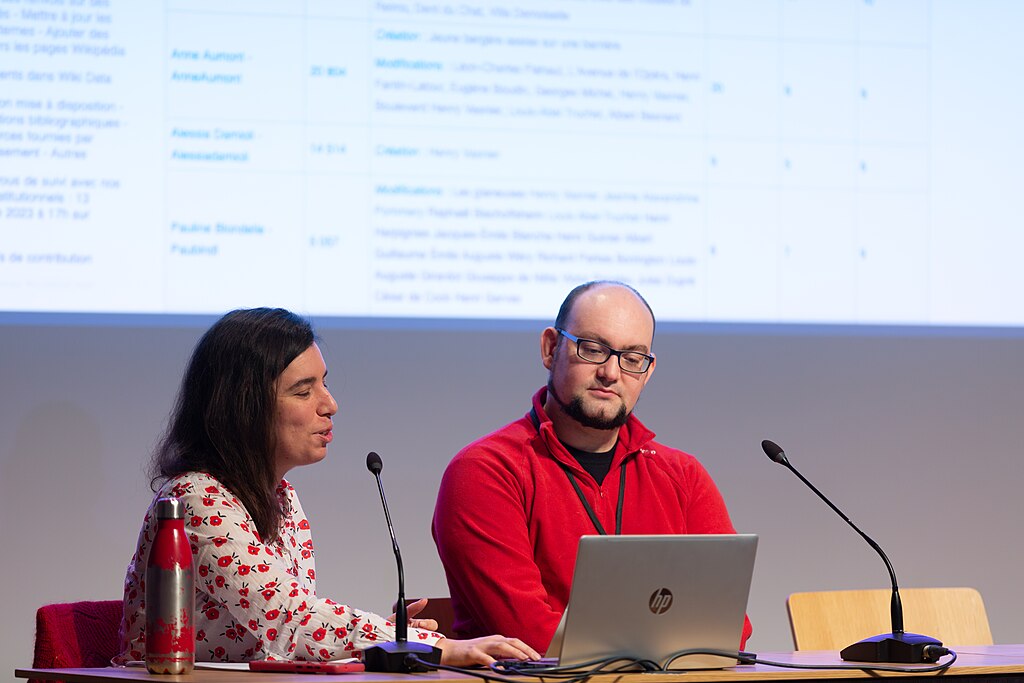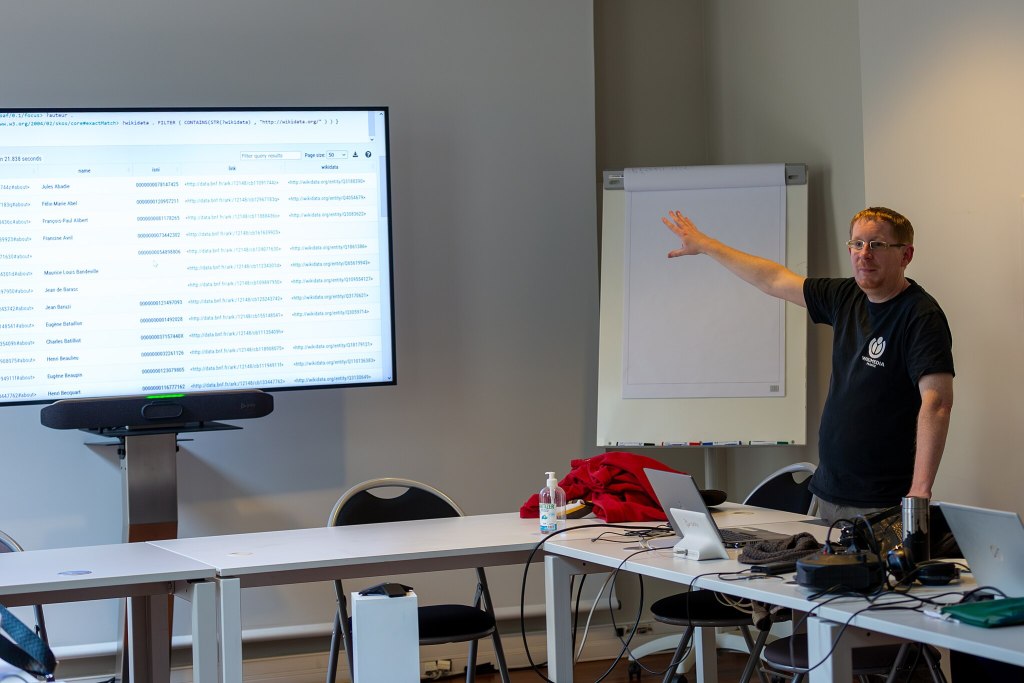Article originally written by Céline Husétowski on Wikimedia France website.
Over 80 people representing 60 cultural institutions attended the 5th edition of the Journée Wikimedia Culture et Numérique organized by Wikimédia France at the Institut National de l’Histoire de l’Art (INHA). As every year, the event brought together cultural institutions aware of the role of Wikimedia projects in their digital strategies. This year, 8 institutions received the label Culture Libre, including a contemporary art museum for the first time.
For this 5th edition, 2 conferences and 2 workshops were offered, once again on the theme of open content and contributing to Wikimedia projects, in partnership with the Archives nationales de France, the Institut national d’histoire de l’art (INHA) and Club Innovation & Culture CLIC (CLIC France).
Teaching students about Wikipedia at the Musée du Louvre
Increasing awareness of the value of heritage on Wikimedia projects starts at university. In 2023, Johanna Daniel, Research Associate at the Institut national d’histoire de l’art and lecturer at the Ecole du Louvre, wanted to develop the seminar she was running on digital uses.
From now on, the seminar will focus on the digital enhancement of heritage, with the participation of a dozen experts in this field, including Lucas Lévêque, trainer in the digital enhancement of cultural and scientific heritage and an experienced contributor to Wikimedia projects. According to him, this seminar “enables students to have a professional relationship with the world’s leading cultural platform.”
Together, they have trained students destined to work in museums or for the art market in the use of Wikipedia and Wikimedia Commons. In addition to a 3-day seminar explaining how the platforms work, the students had to complete a practical exercise. They had to choose from a dozen themes proposed by partner cultural institutions, which provided the bibliography and iconography for the theme. The students were then asked to take stock of the articles already written on the theme on Wikipedia, then to contribute to it and import images.
Totally, 160 Master 2 students were trained, 554 articles were modified and 84 articles were created on Wikipedia. An article on Condate Riedonum written by students was even recognized as a “good article” by the Wikipedia community, proof of its quality. Condate Riedonum is an ancient city in Roman Gaul, now known as Rennes in France.
To see the video recording, click here.
8 new Culture Libre label winners
Launched in 2023, the Culture Libre label was awarded to 8 new institutions on the occasion of the Wikimedia Culture and Digital Day. For this 2nd edition, the jury met from February 15 to March 31, under the aegis of Wikimédia France, and examined 8 applications, all of which were selected.
- Archives départementales de Vaucluse (bronze).
- Sorbonne Université (bronze).
- Château de Montsoreau – Musée d’art contemporain (bronze).
- Bibliothèque du patrimoine de Clermont-Auvergne Métropole (bronze)
- Hospices Civils de Lyon (bronze).
- Bibliothèque municipale de Toulouse (silver).
- Musée d’Art et d’Histoire de Saint-Brieuc (silver)
- Université de Toulouse (silver).

For the first time, a contemporary art museum was awarded the label Culture Libre. The Château de Montsoreau, a UNESCO World Heritage site in the Loire Valley region, was awarded the Bronze level Culture Libre label. The château had begun to freely share its content by sharing artworks from its collections on Wikimedia Commons, and had organized an editathon – 2 essential criteria to qualify for the bronze-level label. “It’s rare that we have artworks by living artists uploaded to Wikimedia Commons,” points out Xavier Cailleau, project manager at Wikimedia France.
To receive the label, the Château de Montsoreau invited artist Filipe Vilas-Boas to present his work. This artist plays with the porosity between IRL and URL world, using open-access content and also sharing his work. He is notably the author of Fusionnaire, the dictionary of language fusion.
The University of Toulouse and the Musée d’art et d’histoire de Saint-Brieuc also came to talk about their practices. The presentation of the Musée de Saint-Brieuc is available on Wikimedia Commons.
Since its launch, the Culture Libre label has been awarded to 24 cultural institutions. “The Culture Libre label has been a recognition of our actions. It has also enabled us to recognize the work of our librarians, who have done a great deal of work in this area”, commented Sophie Toulouze, in charge of digital mediation at Nancy Musées, a few months after the museum was awarded the bronze Culture Libre label.
Discovering and improving knowledge of Wikimedia projects
The Wikimedia Culture and Digital Day was also an opportunity to learn more about Wikimedia projects, either by discovering them or by exploring a particular theme in greater depth. In 2023, the event offered workshops on the choice of licenses, the identification and contractualization process for rights holders, the administrative circuit with supervisory authorities and the organization of a Wikimedian residence. All replays are available online.
In 2024, the day included a workshop around OpenRefine data alignment tool. An “Excel on steroids”, joked Nicolas Vigneron, former Wikimedian-in-Residence who led the course. Openrefine is a free software program for cleaning and formatting data. “Among other things, it can be used to retrieve data from the Internet and export it to Wikidata. It’s of particular interest to librarians who are used to processing large volumes of data”, explains Nicolas Vigneron.
Mickaël Schauli, Wikimdian in residence at the URFIST in Strasbourg, led a workshop entitled “Community, contributions, tools and best practices within Wikimedia France projects”. ” The idea was to pass on best practices for GLAM contributors to Wikimedia projects,” he explains. As staff of cultural institutions, they can contribute, for example, on artworks from the collection, to share knowledge on Wikipedia or Wikimedia Commons.
Note that for the first time this year, Wikimédia France had included eco-practices to help organize the meeting (renting a zero waste kit, publishing the route for car-pooling, limiting printing and promotional items, encouraging people to bring their own water bottles).
Replays of the videos available here.
See all the event pics

Can you help us translate this article?
In order for this article to reach as many people as possible we would like your help. Can you translate this article to get the message out?
Start translation

